home
 Management Management
 Theory and practice of self-management - Lukashevich NP Theory and practice of self-management - Lukashevich NP
|
Theory and practice of self-management - Lukashevich NP
TEST 17. WHAT IS YOUR "INTELLECTUAL COEFFICIENT"?
The test is based on self-assessment of the most important characteristic of the intellect - the speed of mental processes. According to the conclusions of its author G. Eysenck, the speed of mental processes is the fundamental basis of intellectual differences between people. But persistence and perseverance can compensate for the lack of speed of thinking. And with a lack of perseverance, you can lose the advantages that nature has given you, giving you a high rate of thinking. Even if a person is quick-witted and persistent enough, he may be unassembled, prone to hasty actions and non-smoothed. He grasps the first idea that came into his head, not bothering himself with checking whether the decision was right. The poor performance of the "error detector" results in very low test results as inevitably as inadequate speed of thinking and lack of perseverance.
Before you start working with the test, read the instructions, which should be strictly observed.
Instructions.
The "IQ" test characterizes your ability to identify patterns.
To work with the test you are given exactly 30 minutes. Try to solve as many tasks as possible. So do not stay too long on one task, go on to the next one. But do not give up too quickly, be persistent. All 40 tasks in 30 minutes can not be solved by anybody.
The tasks are arranged in order of increasing difficulty.
The answer to the task consists of one number, letter or word. Sometimes you need to choose the answer from the proposed options, sometimes you have to come up with an answer.
The test of G. Eysenck "The coefficient of intelligence (IQ)" is given by: Litvintseva NA. Decree. Op. - P. 137-154.
Notes:
1. Points indicate the number of letters in the missed word. For example, (...) means that the missing word consists of three letters.
2. When using the sequence of letters of the Russian alphabet, do not take into account the letter "e".
3. The answers to the test are given after the tasks.
1. Insert the missing number.
36 30 24 18 __
2. Underline the excess.
Byron Shelley Keats Chamberlain Chaucer
3. Which of the six numbered figures is suitable for an empty box? (Write the number in the box.)
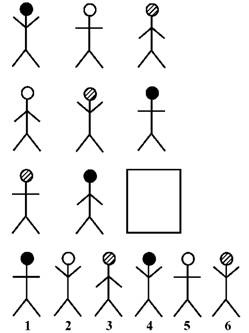
4. Insert the missing number.
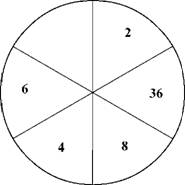
4 9 17 35 __ 139
5. Underline the city, which is superfluous here.
Shanghai Cairo
Lhasa New Orleans
Delhi Quebec
6. Underline the word, which is not the name of the hockey team.
DEPOTRO
MIANDA
ARTAAR
ATPKRAS
OTRKTTA
7. Insert the word in brackets.
Shock (stroke) paralysis detective (....) lard
8. Insert the missing number.
9. Which of the six numbered figures is suitable for an empty box? (Write the number in the box.)
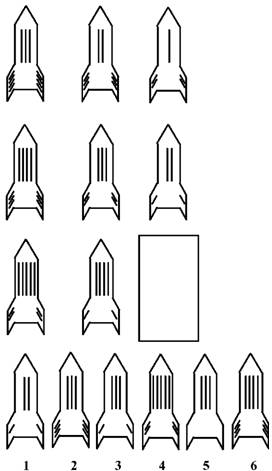
10. Insert the word that ends the first word and starts the second one (key: rigging).
MOTHER
11. Emphasize two of these six figures that do not form a pair.

12. Insert the missing letter.
DYZHM PLIT
13. Insert the missing number.

14. Insert the word in parentheses, which may be preceded by any of the letters on the left.

15. Find the words that mean the same as the words in brackets.
C + (set of rules) = (part of the limb)
16. Insert the missing number.

17. Emphasize the extra word.
Organization: burrow, thunderstorm, horn, grace, lightning, carbon, bazaar.
18. Insert the word that ends the first word and starts the second one (key: verbal information).
KOH (...) IL
19. Which of the six numbered figures is suitable for an empty box? (Write the number in the box.)
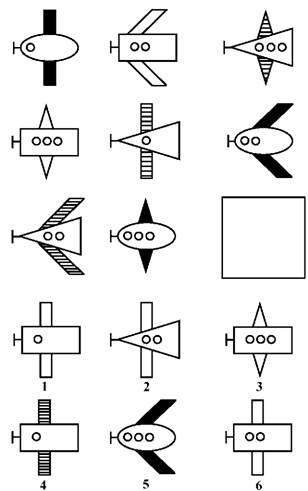
20. Emphasize which of these words is not a female name.
ARYAD
YARIMA
JANTEL
THEENIAARK
21. Insert the missing number.

22. Underline the excess.
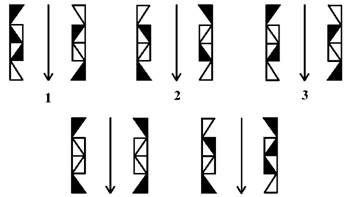
45
23. Add the number missing in parentheses.
188 (300) 263 893 () 915
24. Insert a word that means the same as two words outside the brackets.
Thing (.......) discipline
25. Complete the following correspondence of one of the five numbered pieces. (Stress the right figure.)
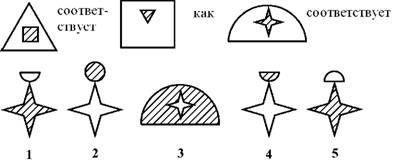
26. Emphasize which of them is not a movie star.
ANDBOR
ORLIGHT
PRALM
ADROB
ANOFD
27. Insert the missing letter.
| FROM | ABOUT |
TO |
H |
Y |
E |
Have |
ABOUT |
28. Which of the six numbered figures is suitable for an empty box? (Write the number in the box.)
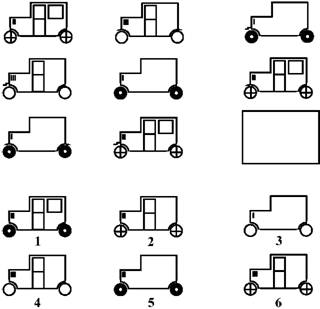
29. Insert the number passed in parentheses.
| 347 | (418) |
489 |
643 |
() |
721 |
30. Which of the six numbered figures is next in this series? (Underline the desired shape.)

31. Insert the missing number.
| 4 | 12 |
10 |
6th |
10 |
3 |
6th |
7th |
6th |
8 |
_ |
5 |
32. Emphasize the extra word.
Aplomb marzipan city corporal cockle
33. Insert the word that ends the first word and starts the second one (key: mode of movement).
TIME (...) UN
34. Insert the missing letter.
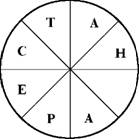
35. Insert the missing number.
48 56

36. Insert the missing letters.

37. Insert the word that ends the first word and starts the second one (key: coin).
PRO (...) NER
38. Underline the phrase that completes the sentence.
Michael bought the castle; Boris bought the hook; Leonid bought the book. Which pair should be next: Joseph and the tube, Gerasim and Mumu, Taras and the cradle, Karl and the clarinet or Leopold and the mouse?
39. Insert the letter that ends the row.
EXTRA P __
40. Insert the missing number.

ANSWERS TO THE TEST
1. 12. (Numbers decrease every six.)
2. Chamberlain. (He is not a poet.)
3. 2. (The hands are raised up, down, at the shoulder level, the head is white, black or shaded in each row of the column.)
4. 69. (Each number is equal to twice the previous and one, alternately added or subtracted from the result.)
5. Quebec. (All the rest are at about the same latitude, Quebec is much farther north.)
6. Ararat. (Torpedo, Dynamo, Spartak and Tractor - hockey teams, Ararat - only football.)
7. The fat. (The word in the middle has the same meaning as the two words outside the brackets, the fat is fat, and the detective.)
8. 64. (One of the numbers located opposite to each other is the square of the other, 8 in the square is 64.)
9. 5. (The number of lines inside and on the rocket's stabilizers decreases from the beginning to the end of the series.)
10. CBC.
11. 2 and 4. (1 and 5, 3 and 6 form pairs, one figure is obtained from the other by a 180 degree turn, for 2 and 4 this does not hold.)
12. J. (There are two alternating series of letters, in each two letters are skipped, letting Z and II, we get J.)
13. 79. (The difference between two numbers in each pair is always equal to twenty-one, the bottom number is always greater.)
Thus: 58 + 21 = 79.
14. ROLE.
15. Constitution and joint. (C + statute = joint.)
16. 4. (In each row the second number is subtracted from the first and multiplied by four: 7 - 6 = 1; 1 .4 = 4.)
17. The Bazaar. (All other words can be formed from the letters of the word "organization.")
18. TEXT.
19. 1. (There are three forms of the fuselage, three kinds of wings, one, two or three places in the cockpit, and the wings are white, black or shaded.) Each shape occurs only once in each row and in each column.)
20. LENTYAI. (Female names are Daria, Maria and Catherine.)
21. 21. (Two numbers are multiplied from above and the bottom number is subtracted from the result: 9.3 = 27; 27 - 6 = 21.)
22. 4. (1 and 5, 2 and 3 are complementary to each other in triangles, which are white in one figure and black in the other.
4 does not correspond to this scheme. In addition, in those figures, the two sides (right and left of the arrow) complement each other; In 4 they are the same.)
23. 88. (The number in parentheses is four times larger than the difference between numbers outside parentheses.)
24. Subject.
25. 4. (A large figure is turned over and placed on top of a small figure, a small figure becomes large, and a large one becomes small, the shaded figure becomes one-color, and vice versa.)
26. MARPL. (Movie Stars: Brando, Taylor, Bardot and the Foundation.)
27. I. (The letters in the second column are formed by upwards in alphabetical order, respectively, by two, three and four letters relative to the letters of the first column.The letters in the third column are formed by going up alphabetically with respect to the letters of the second column by three, four and five letters respectively Five letters from O are I.)
28. 4. (Each row and column contains one car with solid wheels, one with white wheels and one with a cross on wheels, maybe one, two or three slots on the hood.) Maybe a door and a window, just a door or not There may be a crank handle or a wing, or neither one, nor the other.) The answer corresponds to this set of characteristics.)
29. 682. (The number in parentheses is equal to half of the sum of the numbers in parentheses.)
30. 1. (The large square turns anti-clockwise every 45 degrees, the cross and the circle rotate the same angle, but clockwise.)
31. 9. (The number in the third column is formed by adding the numbers in the first and second columns and subtracting the number from the last column: 6 + 8 - 5 = 9.)
32. Kubrick. (In all other words, the first and last letters follow each other in alphabetical order, they are the same in the word "kubrick".)
33. RUN.
34. T. (The letters read clockwise form the word "prisoner.")
35. 89. (All numbers outside the circle are divided in half and the results add up.)
36.

(Two letters are passed from above, three, four and five are skipped from the bottom.)
37. CENT.
38. Taras and the cradle. (The number of letters in the names is 6, 5, 6. The next letter should also have 5 letters, the number of letters in objects 5, 6, 5, the next one again has to be 6. The phrase "Taras and cradle" satisfies this regularity.)

40. 112. (In each domino, the lower number is obtained from the top by raising it to a square, dividing by two, and subtracting the upper number from the result.) Square 16 = 256; 256: 2 = 128; 128 - 16 = 112.)
Graph for evaluation of test results
The test result is determined by the schedule. Mark the number of correctly assigned tasks on the horizontal line, then draw a vertical line to the intersection with the diagonal line. From the intersection point, draw a horizontal line to the left. The point on the vertical axis corresponds to your IQ.
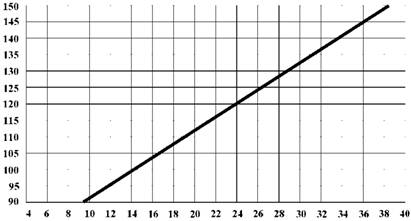
The numbers on the horizontal scale are the number of points scored by you, that is, the number of correct answers. Draw a vertical line to the intersection with the diagonal and determine the numerical value of this point on the vertical scale. This will be your level. Naturally, the higher it is, the better.
Analysis of the results of the test "IQ"
The "Intelligence Coefficient" test is widely used in the United States, as well as in other countries. It was first used in 1905 in France to identify especially gifted children. The results of numerous studies have allowed foreign specialists to make the following generalizations:
50% of people have IQ from 90 to 110;
25% of people have IQ above 110 and 25% have below 90;
IQ = 100 - the most common result;
14.5% of people have IQ = 110-120;
7% - 120-130;
3% - 130-140;
0.5 - above 140;
IQ below 70 indicates a mental retardation.
Among high school students of American schools the most common result is IQ = 115, among the students-honors IQ = 135-140.
People under 18 years of age or older than 60 years in testing usually show lower results.
Analyze which tasks are easier for you to give - verbal, numeric or spatial, this characterizes the type of your thinking. Women usually solve verbal tasks better, more difficult - spatial. Men are more successful in solving spatial and numerical tasks.
However, we note that the intelligence coefficient does not take into account other professionally important qualities of the leader and just a person - such as decency, reliability, kindness and many others, self-assessment and self-development should also not be forgotten.


Comments
When commenting on, remember that the content and tone of your message can hurt the feelings of real people, show respect and tolerance to your interlocutors even if you do not share their opinion, your behavior in the conditions of freedom of expression and anonymity provided by the Internet, changes Not only virtual, but also the real world. All comments are hidden from the index, spam is controlled.